Vietnamese Comfort in a Bowl
Sticky, sweet, salty, and fall-apart tender, Sườn Kho or Vietnamese Caramelized Pork Spare Ribs is Vietnamese comfort food at its best. These pork ribs are braised in a savory caramel sauce until they’re coated in pure flavor and melt in your mouth.
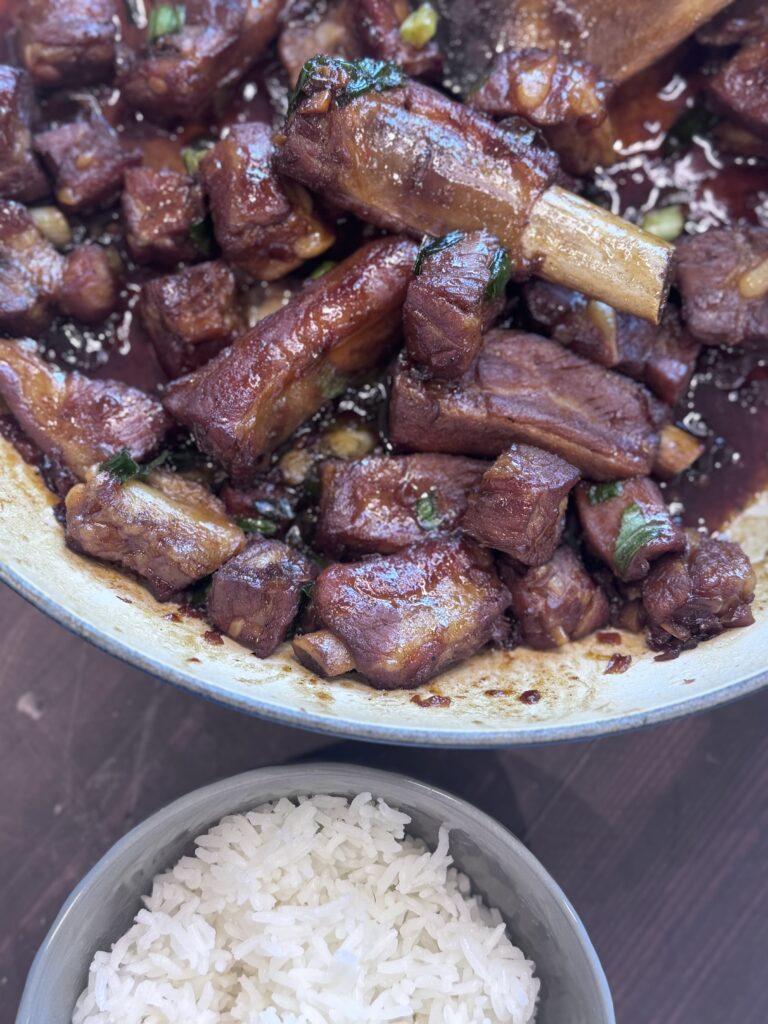
Sườn Kho is one of my top Vietnamese comfort dishes, and for good reason. It’s everything I crave in one meal: tender pork ribs, sweet-savory caramel sauce, a hot bowl of jasmine rice, and crunchy cucumber slices to cool it all down. And yes, if you’re fancy, pickled mustard greens are the ultimate bonus bite.
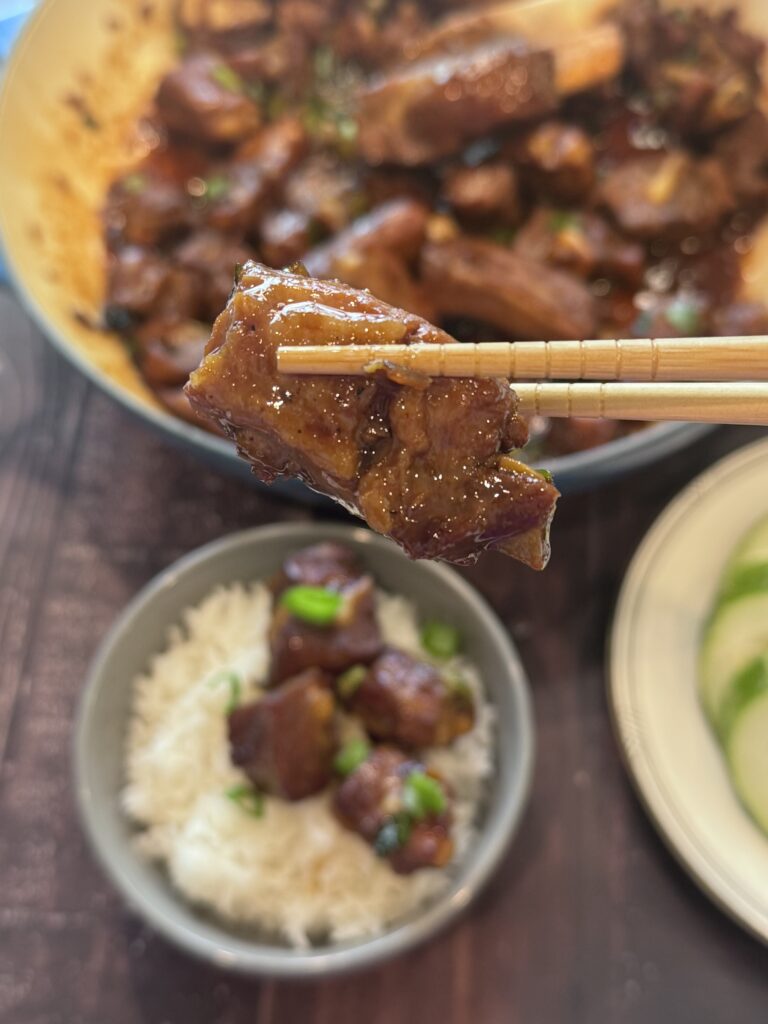
In Vietnamese, “kho” means to braise—and like all good braises, this one just needs time. Time for the coconut water to seep into the meat. Time for the fish sauce to work its magic. And time for you to resist poking at the pot every five minutes.

The real star here is the caramel sauce. A bit sweet, a little smoky, and deeply rich, it wraps around the ribs like a sticky hug. And trust me, once you master caramelizing sugar in oil (pro tip: don’t walk away), you’ll want to kho everything.
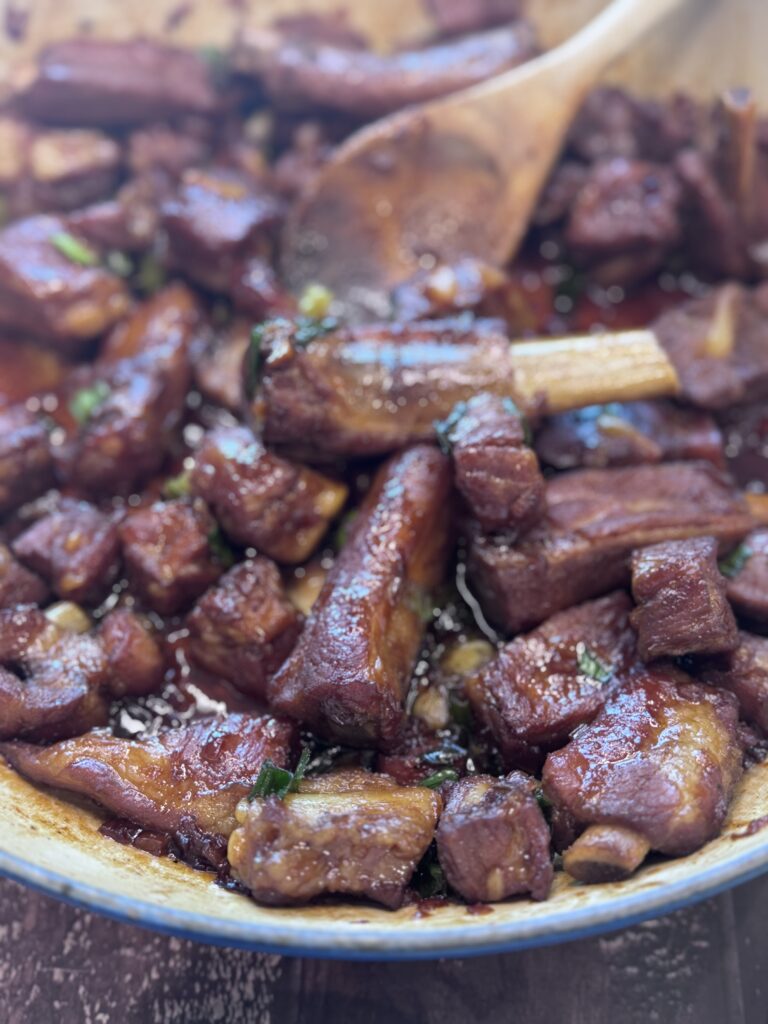
Why this Recipe Works
• Deeply savory and balanced – Fish sauce, oyster sauce, and coconut water combine for a rich, nuanced flavor.
• Braising transforms ribs – Tender, juicy meat with that “fall-off-the-bone-but-still-has-bite” texture.
• Caramel sauce = magic – Made from just sugar and oil, it gives the whole dish its gorgeous color and flavor.
• Great with rice – The sauce-to-rice ratio is pure heaven. Prepare to eat more rice than planned.
• Even better the next day – Like all good braises, the flavor deepens overnight. Leftovers? Iconic.
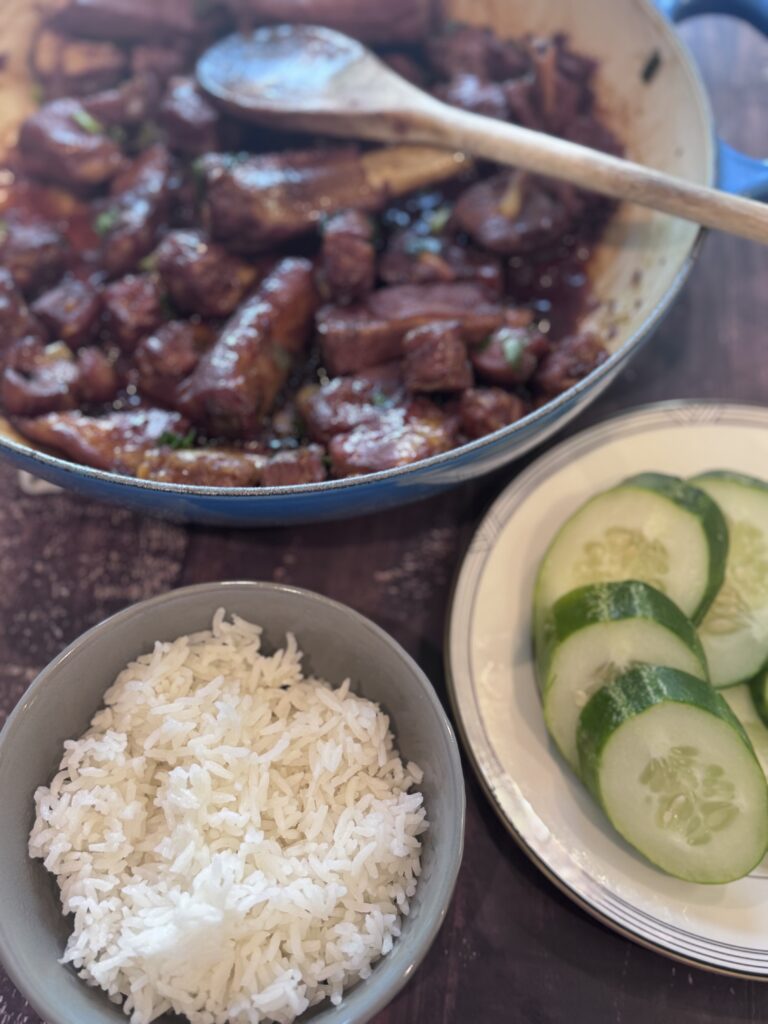
Tips for Making Vietnamese Caramelized Pork Spare Ribs
• Don’t walk away from the caramel – Sugar goes from golden to burnt faster than your last situationship. Once it hits amber, be ready to move.
• Parboil your pork – This step may feel extra, but it helps remove scum and gives your final dish a cleaner, purer flavor. Your pot—and your taste buds—will thank you.
• Use Coco Rico if you can – This coconut soda adds sweetness and depth that plain coconut water just can’t replicate. It’s like the secret handshake of Sườn Kho.
• Cut the ribs evenly – Stick to 1½-inch pieces so they cook evenly and soak up that glorious caramel sauce.
• MSG is optional, not evil – If you’re cool with it, use it. If not, skip it. But don’t be afraid—it brings legit umami to the party.
• Coconut sugar = deeper flavor – Sub it for regular sugar if you want a rounder, molasses-y vibe.
• Let it braise gently – No fast boiling here. A low simmer lets the flavor seep into the meat and makes everything tender without falling apart.
• Make extra rice – You will want to drown your bowl in sauce, and that rice is going to need backup.

🌱 A Bite of Sustainability
Making this dish at home allows you to skip the takeout packaging and use better-sourced ingredients. Coconut water and fish sauce have relatively low environmental impact, and using pork ribs from a trusted local butcher helps support more ethical meat production. Serving with rice and cucumbers adds seasonal, low-waste elements to a dish that’s full of flavor and care.
How To Make Vietnamese Caramelized Pork Spare Ribs (Suon Kho)
Vietnamese caramelized pork spare ribs (Sườn Kho) are braised in a savory-sweet sauce with coconut water, garlic, and fish sauce. Perfect with rice and cucumbers.
Parboil the Ribs
1. Bring a large pot of water to a boil. Add 1 teaspoon salt.
2. Add pork ribs and boil for 5–10 minutes to remove impurities.
3. Drain and rinse under cold running water to remove scum. Set aside.

Make the Caramel
1. In a braiser or heavy-bottomed sauté pan, heat vegetable oil over medium heat.
2. Add sugar and let it melt—do not stir excessively.
3. Let the sugar cook until it turns a deep amber brown.
🔥 Don’t walk away—once it goes dark brown, it’s seconds from burning.
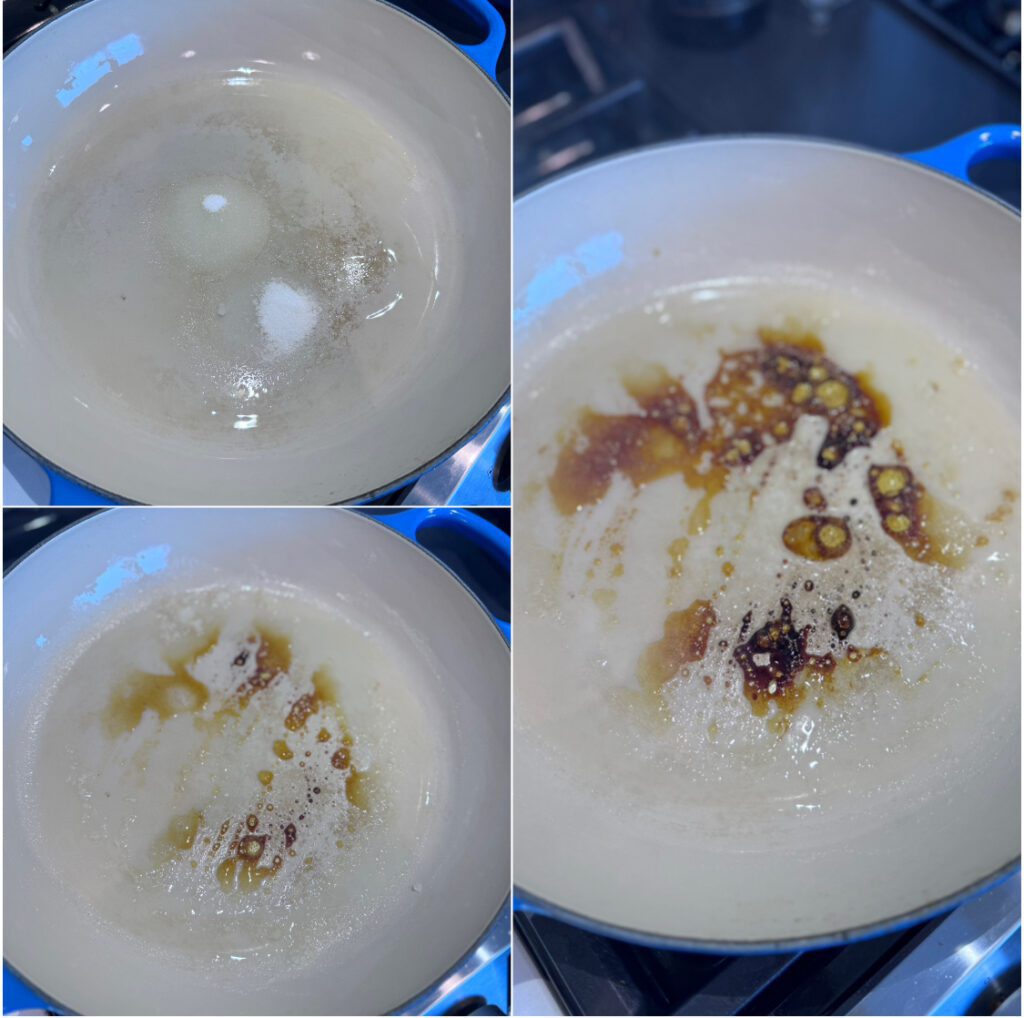
Braise the Ribs
1. Add garlic and shallots to the caramel and sauté until fragrant (1–2 minutes).
2. Add pork ribs, tossing to coat in the caramel.
3. Add fish sauce, oyster sauce, and stir to combine.
4. Pour in coconut water, pepper, garlic powder, paprika, and MSG (if using). Mix well.
5. Bring to a boil, then reduce to simmer. Cover and cook for 35 minutes, stirring occasionally. Uncover and garnish with scallions.

Serve
1. Once ribs are tender and glazed, garnish with scallions.
2. Serve with steamed rice, fresh cucumber slices, and optionally, pickled mustard greens.

The Final Kho Down
Sườn Kho is a dish that demands patience—but pays it back in spades. That sticky caramel glaze? Worth every second of stovetop devotion. The tender ribs, the bold sauce, the cozy rice-to-bite ratio… it’s Vietnamese comfort food that always delivers. Whether it’s your first time braising or your fiftieth, this dish is a warm, flavorful hug on a plate.
Now, go kho yourself something delicious.
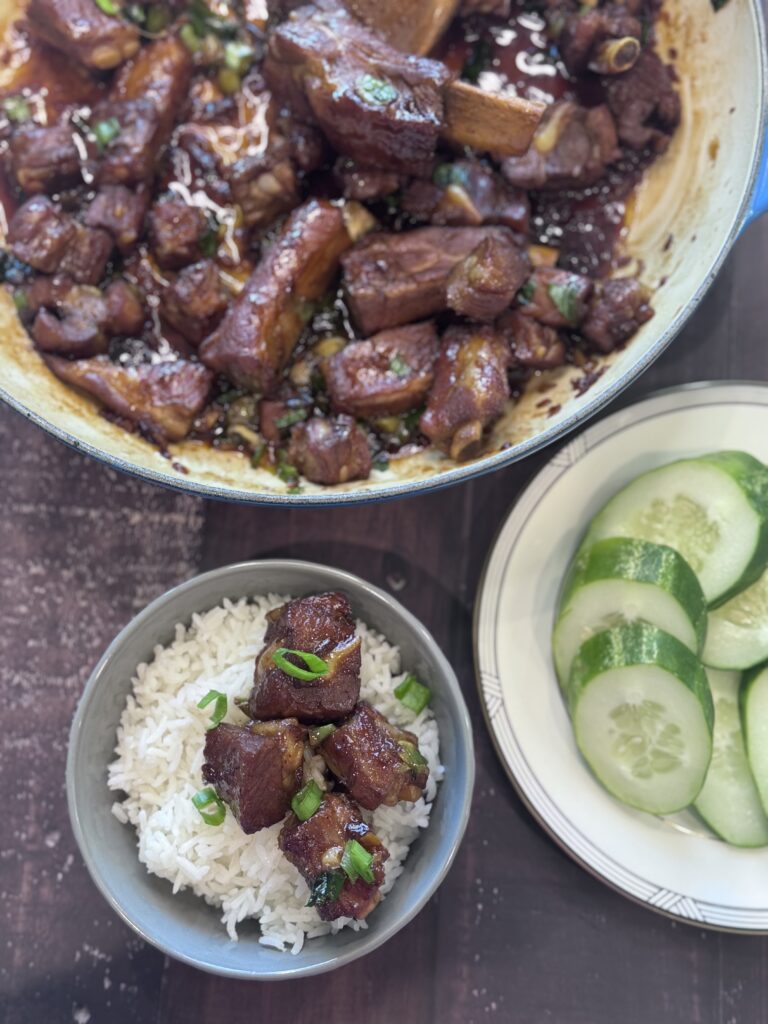

Vietnamese Caramelized Pork Spare Ribs (Suon Kho)
Description
Vietnamese caramelized pork spare ribs (Sườn Kho) are braised in a savory-sweet sauce with coconut water, garlic, and fish sauce. Perfect with rice and cucumbers.
Ingredients
Nutritional Value
Nutritional Value
Servings 8
Serving Size 1
- Amount Per Serving
- Calories 141kcal
- % Daily Value *
- Total Fat 5.99g10%
- Saturated Fat 1.81g10%
- Trans Fat 0.0009g
- Cholesterol 55mg19%
- Sodium 558mg24%
- Potassium 364mg11%
- Total Carbohydrate 4.97g2%
- Dietary Fiber 0.6g3%
- Sugars 3.15g
- Protein 16.08g33%
- Vitamin A 142 IU
- Vitamin C 1.3 mg
- Calcium 30 mg
- Iron 0.93 mg
* Percent Daily Values are based on a 2,000 calorie diet. Your daily value may be higher or lower depending on your calorie needs.
Note
- When making caramel, do not walk away. If the caramel turn black, it's burnt and you'll want to start over because the dish will taste bitter.
- I love to use Coco Rico, but any coconut water can be used.
- Coconut sugar can be substituted for granulated sugar.
- Parboiling the pork will remove impurities from the meat. Make sure you rinse the pork well to remove any scum.
- Caramelizing can be tricky. Do not walk away from the pot while the sugar cook. No need to stir continuously as the sugar will cook with the oil and turn a brown color fairly quickly.














